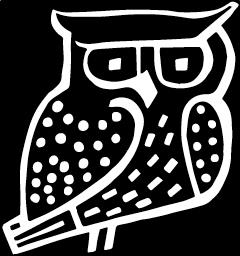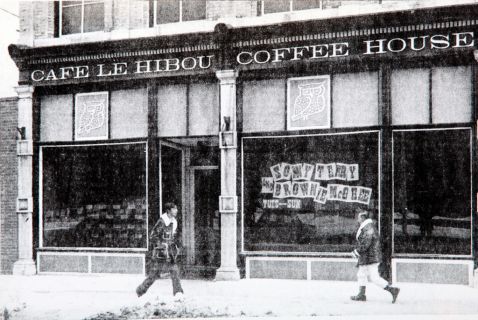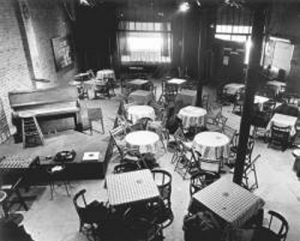Hipster Ottawa: Café Le Hibou | Ottawa, une ville cool: Le café Le Hibou
By: Lindsay M. (Youth Council Member)
Ottawa is a city brimming with history. When walking through downtown, you can feast your eyes on an abundance of historical sites: Parliament Hill, the Rideau Canal and more. What isn’t as visible is the lost history of Ottawa, especially the demolished buildings or the closed institutions. Café Le Hibou, a long-gone but legendary coffeehouse that hosted art of all forms from 1960 to 1975, is one of Ottawa’s lost historical sites right under our noses.

University of Ottawa students Denis Faulkner, André Jodouin, Jean Carrière, and George Gordon-Lennox opened the café in 1960 at 544 Rideau Street, above a chiropractic office. Faulkner wanted to open the café after working in Edmonton and visiting live music clubs there. Ottawa in the 1950s, according to Faulkner, was considered the “capital of boredom,” with few places for youth to meet. The cultural scene in the city floundered; concerts at the now-demolished Capitol Theatre were limited to classical music and the odd pop act, the Ottawa Little Theatre was the primary source of amateur theatre, and the National Arts Centre would not open until 1969.
Faulkner thought that Ottawa “should have a little club for students and others, a place to meet and exchange ideas, listen to some good jazz or folk music.” Faulkner, Carrière, and Gordon-Lennox each pitched in $800 – the cost of a full year’s tuition at the university – and Jodouin offered his services as a live-in manager. Membership cost $1. Locals would drop in to read poetry or play music. By the end of the first winter, there were more than 500 members. The café needed a larger space where they could host paid entertainment, as the landlord downstairs expressed frustration of the noise and crowds.

In October 1961, the coffeehouse moved to 248 Bank Street. Harvey Glatt, the owner of a local record store, invested another $800 in becoming a part-owner. The club’s membership continued to grow, and soon this space was too small as well. Space was so limited that there was no backstage area, and performers had to get ready for their acts in an open area by the back door.
In 1965, the café moved to 521 Sussex Drive, its final location. The National Capital Commission owned the building, charging the café below-market rent. They saw the café as a way to develop the Byward Market as an essential hub of Ottawa nightlife. The Canada Council for the Arts subsidized readings by Canadian poets, and the CBC sponsored some shows by local jazz groups. The community supported the club as well, and local graphic artists created event advertisement posters for free.
In 1968, Faulkner sold the café to its night manager John Russow and his wife Joan so Faulkner could advance in his career at the CBC. In the spring of 1972, Pierre Paul Lafrenière bought the club; he would be Le Hibou’s last owner.

Throughout the years, Le Hibou hosted hundreds of musicians, poets, and performance artists. Citizens of Ottawa saw the café as a beacon of culture, presenting everything from live music to theatre and dance to film. Many Canadian artists developed their reputations at Le Hibou, including Dan Aykroyd, Joni Mitchell, and Gordon Lightfoot. George Harrison visited the club in 1969, wanting to scout an artist for Apple Records. The café was very popular with locals as well. Shortly after his swearing-in as prime minister, Pierre Elliot Trudeau visited late at night, upset that he had missed the night’s show, and he signed a poster before he left.
Café Le Hibou closed on May 3, 1975. Many elements factored into the closure, including competition from licensed clubs and a rent increase from $450 a month to $2,000. Singer-songwriter Sneezy Waters, who had his first performance at Le Hibou, remembers how on the last day the café was opened, “there was gnashing of teeth and wailing and a pretty heavy sadness … It was hard to imagine it would be gone.”
Although closed for over forty years now, Café Le Hibou is not forgotten. Denis Faulkner keeps a website with his recollections of the Café, and local authors have published histories of the institution. These are valuable reminders of essential elements of Ottawa’s local and cultural history, reminding us that downtown has a long and varied, but sometimes invisible, history.
par Lindsay M. (membre du conseil)
Ottawa est une ville débordante d’histoire. Au centre-ville, vous vous régalerez de la vue de multiples lieux historiques : la colline du Parlement, le canal Rideau et d’autres encore. Mais l’histoire perdue d’Ottawa, en particulier celle des édifices démolis et des établissements fermés, apparaît moins. Le légendaire Café Le Hibou, depuis longtemps fermé, a accueilli différentes formes d’art de 1960 à 1975, dans l’un des lieux historiques perdus d’Ottawa, juste sous nos yeux.

Denis Faulkner, André Jodouin, Jean Carrière et George Gordon-Lennox, étudiants à l’Université d’Ottawa, ont ouvert le café en 1960, au 544 rue Rideau, au‑dessus du cabinet d’un chiropraticien. Faulkner décida d’ouvrir le café après avoir travaillé à Edmonton et visité des clubs présentant de la musique en direct. Selon Faulkner, Ottawa était considérée dans les années 1950 comme « la capitale de l’ennui », offrant peu de lieux de rencontre aux jeunes. La scène culturelle de la ville s’enlisait. En concert ou au Capitol Theatre – aujourd’hui démoli –, on ne jouait que de la musique classique ou de la musique pop singulière; le théâtre amateur se cantonnait principalement à l’Ottawa Little Theatre; et le Centre national des Arts n’a ouvert ses portes qu’en 1969.
Faulkner pensait qu’Ottawa devrait « avoir un club pour étudiants et autres jeunes, un lieu de rencontre permettant d’échanger des idées, d’écouter du bon jazz ou de la musique folk ». Faulkner, Carrière et Gordon-Lennox ont chacun versé 800 dollars (l’équivalent d’une année de frais de scolarité), et Jodouin a offert ses services comme gérant. Le coût d’adhésion s’élevait à un dollar. Des gens de la région venaient lire des poèmes ou jouer de la musique. Dès la fin du premier hiver, le café comptait plus de 500 membres; il fallut alors trouver un lieu plus grand pouvant accueillir des spectacles payants sans déranger le propriétaire, qui s’était plaint du bruit et de l’importante fréquentation.

En octobre 1961, le café déménagea au 248 rue Bank. Harvey Glatt, propriétaire d’un magasin local de disques, investit un montant supplémentaire de 800 $ pour devenir associé. Le nombre de membres continua de croître et bientôt, le local fut de nouveau trop petit, au point qu’il n’y avait pas de coulisses. Les artistes devaient se préparer dans un endroit ouvert près de la porte arrière.
En 1965, le café déménagea au 521 promenade Sussex, sa destination finale. La Commission de la capitale nationale, qui possédait l’édifice, avait consenti un loyer inférieur au prix du marché. Ses responsables espéraient que le café permettrait de développer le marché By et d’en faire un foyer de la vie nocturne à Ottawa. Le Conseil des arts subventionna les lectures faites par des poètes canadiens, et la CBC commandita des concerts de jazz présentés par des groupes locaux. La collectivité appuya également le café, et des artistes locaux en arts graphiques réalisèrent gratuitement des affiches annonçant les spectacles.
En 1968, Faulkner vendit le café à son gérant de nuit, John Russow, et à sa femme Joan, afin de faire progresser sa carrière à la CBC. Au printemps de 1972, Pierre Paul Lafrenière acheta le café. Il a été le dernier propriétaire du Hibou.

Au fil des années, Le Hibou a accueilli des centaines de musiciens, de poètes et d’artistes. Les citoyens d’Ottawa considéraient le café comme un phare culturel offrant toutes sortes de représentations, de la musique en direct au théâtre, à la danse et au cinéma. Nombre d’artistes canadiens ont établi leur réputation au Hibou, dont Dan Aykroyd, Joni Mitchell et Gordon Lightfoot. George Harrison a visité l’endroit en 1969, désireux de découvrir un artiste pour Apple Records. Le café jouissait aussi d’une grande popularité locale. Peu après avoir prêté serment comme premier ministre, Pierre-Elliot Trudeau s’y rendit tard en soirée, mécontent d’avoir manqué le spectacle, et il signa une affiche avant de partir.
Le café Le Hibou ferma ses portes le 3 mai 1975. Plusieurs facteurs ont provoqué cette fermeture, notamment la concurrence de débits de boisson autorisés et l’augmentation du loyer, passé de 450 dollars à 2 000 dollars par mois. Sneezy Waters, auteur-compositeur-interprète qui avait fait sa première apparition sur scène au Hibou, se rappelle comment, le dernier jour, « il y avait des grincements de dents, des lamentations et une grande tristesse […] Il était difficile d’imaginer que c’était fini. »
Même si le café Le Hibou est fermé depuis plus de 40 ans, sa réputation demeure. Denis Faulkner tient un site Web comprenant des souvenirs du café, et des auteurs locaux publient des histoires sur l’établissement. Ces rappels précieux font revivre une partie essentielle de l’histoire locale et culturelle d’Ottawa, nous rappelant que le centre-ville possède une histoire longue et variée, mais parfois invisible.
